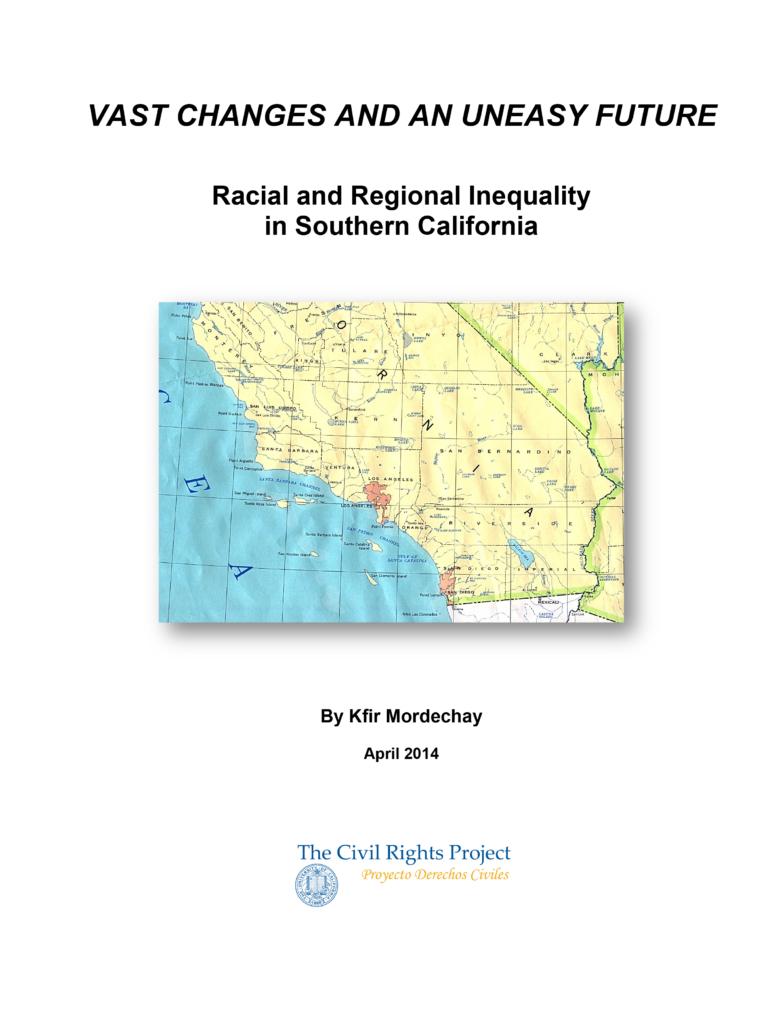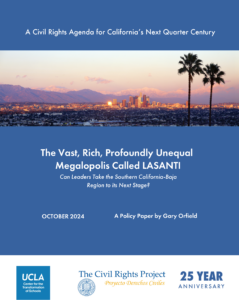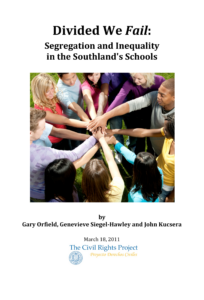Executive Summary
One of the largest and most complex urban areas in the world is in the midst of a sweeping demographic transformation, from which we can infer a future population of children growing up with radically different opportunities. This great international megalopolis stretches the six counties comprising the Southern California region–Los Angeles, San Diego, San Bernardino, Riverside, Orange, and Ventura counties–in addition to the Baja region of Mexico on the other side of the border. This huge region we have called “Lasanti”, possesses an international boundary constituting the largest economic differential of any border in the world. It is a mega-region characterized by an increasing geographic divide, accentuated by the major migration of blacks and Latinos to suburban areas in Southern California with municipal economies that are less robust producing very different intergenerational patterns of opportunity. The change in the region’s racial composition is massive and the population growth of young people (that the region has counted on for many years) has waned. The great majority of the babies born in the Southern California region are members of minority groups, suggesting that the region’s destiny is in the hands of a rapidly growing and economically stratified population.
The region’s educational systems will shape the majority of the next generation of workers, and vies versa. It is therefore essential that we nurture the region’s human capital, and attend to its changing needs. As illustrated by the data in this report, the region’s youth have a significantly higher poverty rates than the region’s adults, so many of those future workers will grow up in poverty. Poverty limits access to housing in stable neighborhoods, which, in turn, limits access to good schools, setting in motion a vicious cycle of intergenerational poverty. Complacency on the part of policymakers is likely to lead not only to enhanced inequality and increased internal stratification, but also to sever social and economic decline.
Major findings in this report include:
Change and poverty in the population of children
- A population decline of 275,000 children by 2010 from its peak in 2003.
- A 1.3 million increase in Hispanic children (0-14) from 1990 to 2010, a 51.5% increase.
- A more than three times higher child poverty rate for black (33.5%) andHispanic (30.2%) children than that of whites (8.9%).
Change in migration
- A more than 10% decline of legal migration in Los Angeles County since 2008, with that sharpest decreases in the Inland Empire counties of Riverside (over 18%) and San Bernardino (over 13%).
- A 5.7% decrease in L.A. County’s undocumented population between 2001 and 2009; conversely Riverside and San Bernardino County saw increases of 75.6% and 34%, respectively.
- A decline of more than 10% in legal migration in Los Angeles County since 2007, with sharper reductions occurring in the two Inland Empire Counties, with Riverside experiencing a decline of over 18% and San Bernardino a decrease of over 13%.
Declining birth rates
- A 12.3% reduction in LA County birthrates from 2007 to 2010.
- A decrease in births across Baja California to 1.7 children for every woman of childbearing age (ages 15 to 49), compared to 1.9 children in 2000.
Decrease in white toddler population
- A decline in Orange County’s white toddler population (0-5) from 36.5% to 28.1% of the total toddler population between 2000 and 2010.
- A decrease in Orange County’s white population from almost 90% of the total population in 1970 to 43.5% in 2010.
- A twenty-two time increase in Orange County’s Asian Population since 1970, while the Hispanic population has increased over 700% in the same time frame.
- A reduction of 28% the Inland Empire Counties white toddler population.
Increase in minority population
- A more than two million decrease in white residents in LA County since 1970.
- 47.8% of the total population over 40 years of age in urbanized Southern CA is white, 25.8% is under 40. By contrast, 30.2% of the population over 40 is Hispanic, compared to 48% of the total that is under 40 years old.
- Riverside County has seen an almost 600% increase in its black population in the last 40 years.
International immigration, changes in birth rates and internal migration patterns interact in increasingly complex ways to create massive demographic transformation and deep divisions in metropolitan societies. Given the trends presented in this report, it is clear that there is a serious risk to equality of opportunity in this great region. Inequality runs deep, and the diversity of peoples and economies in Lasanti presents a multifaceted and complicated portrait of inequality. If policymakers are interested in preparing the next generation of skilled workers to ensure a healthy and vibrant economy, they must insist that these patterns be changed.
This paper is part of the LASANTI Project, which explores many dimensions of social and economic change and inequality across the huge bi-national urbanized complex, stretching from the northern Los Angeles suburbs down through San Diego, to the Tijuana metropolitan area.
See a full description of The Lasanti Project here.
In compliance with the UC Open Access Policy, this report has been made available on eScholarship:





